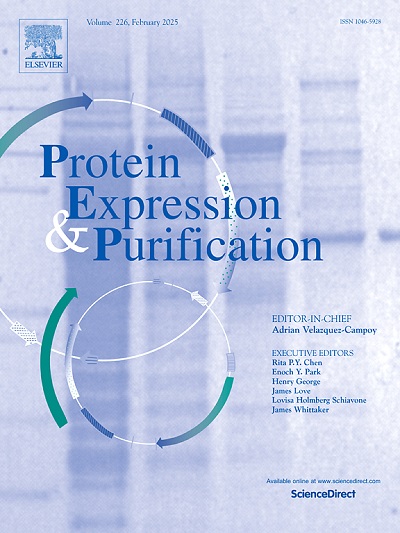Refolding of the Deinococcus Radiodurans phytochrome photosensory module and an extended backbone resonance assignment by solution NMR
IF 1.2
4区 生物学
Q4 BIOCHEMICAL RESEARCH METHODS
引用次数: 0
Abstract
Solution NMR reveals the structure and dynamics of biomolecules in solution. In particular, the method can detect changes due to perturbation of the molecules, without limiting effects of frozen particles or crystal environments. Phytochromes are photosensors which control the response to red/far-red light in bacteria, fungi and plants, undergo specific structural changes when photoactivated from the Pr to the Pfr state. While structures of phytochromes have been revealed in both states, the structural mechanism of photoconversion remains incompletely understood. Our previous NMR studies of the entire photosensory core module of the D. radiodurans phytochrome have revealed novel structural changes, but the backbone assignment was incomplete. In particular, a lack of the assignment in the protein core hindered more detailed insight in signaling mechanism. Here, we outline an efficient procedure for the refolding of the three-domain, photosensory core fragment of the D. radiodurans phytochrome in its monomeric form. We find that treatment with guanidinium hydrochloride and subsequent dilution effectively refolds the phytochrome, maintaining its functionality. We characterize the refolded protein with solution NMR spectroscopy newly assigning 27 (44) residues in Pr (Pfr), out of which 12 exhibit notable chemical shift perturbation upon photoactivation. The study presents a functional method for purification and refolding of a multidomain protein and opens the door for further structural and dynamic analysis of phytochromes.
Author summary
Refolding of proteins is an established method to increase the deuterium-hydrogen exchange of amid bonds in isotopically labeled proteins, which are located deep in the protein core. Yet, the method has to be optimized for each individual protein and in particular for multidomain proteins it is not trivial to find satisfactory experimental conditions. Here we identify a method to refold a D. radiodurans phytochrome construct and characterize the outcome of the procedure using solution NMR and optical spectroscopy. The quick accessibility on whether the refolded phytochrome was functional or not has been obtained from optical spectra, which also made the screening of a number of additives possible. The procedure led to a significant increase in the number of the assigned residues especially in the protein core, close to the photochemically active chromophore, which enables a more detailed investigation of the structure and dynamics throughout the photocycle of the phytochrome.
耐辐射球菌光敏色素光感模块的再折叠和溶液核磁共振扩展主共振分配。
溶液核磁共振揭示了溶液中生物分子的结构和动力学。特别是,该方法可以检测由于分子扰动引起的变化,而不受冻结颗粒或晶体环境的限制。光敏色素是控制细菌、真菌和植物对红光/远红光响应的光传感器,当从Pr状态光激活到Pfr状态时,会发生特定的结构变化。虽然光敏色素在两种状态下的结构已经被揭示,但光转化的结构机制仍然不完全清楚。我们之前对D. radiodurans光敏色素整个光敏核心模块的NMR研究发现了新的结构变化,但骨架分配不完整。特别是,缺乏蛋白质核心的分配阻碍了对信号传导机制的更详细的了解。在这里,我们概述了一种有效的程序,以其单体形式重新折叠D. radiodurans光敏色素的三域光敏核心片段。我们发现用盐酸胍处理和随后的稀释有效地重新折叠色素,保持其功能。我们用溶液核磁共振光谱表征了重新折叠的蛋白质,在Pr (Pfr)中新分配了27(44)个残基,其中12个在光激活时表现出明显的化学位移扰动。该研究提出了一种纯化和重折叠多结构域蛋白的功能方法,为进一步分析光敏色素的结构和动力学打开了大门。蛋白质重折叠是一种建立的方法,用于增加位于蛋白质核心深处的同位素标记蛋白质之间键的氘氢交换。然而,该方法必须针对每个单独的蛋白质进行优化,特别是对于多结构域蛋白质,要找到满意的实验条件并非易事。在这里,我们确定了一种方法来重组D. radiodurans光敏色素结构,并利用溶液核磁共振和光谱学表征了该过程的结果。从光谱上可以快速判断折叠后的光敏色素是否具有功能,这也为筛选一些添加剂提供了可能。这一过程导致分配残基的数量显著增加,特别是在蛋白质核心,接近光化学活性发色团,这使得在光敏色素的整个光循环过程中更详细地研究结构和动力学。
本文章由计算机程序翻译,如有差异,请以英文原文为准。
求助全文
约1分钟内获得全文
求助全文
来源期刊

Protein expression and purification
生物-生化研究方法
CiteScore
3.70
自引率
6.20%
发文量
120
审稿时长
32 days
期刊介绍:
Protein Expression and Purification is an international journal providing a forum for the dissemination of new information on protein expression, extraction, purification, characterization, and/or applications using conventional biochemical and/or modern molecular biological approaches and methods, which are of broad interest to the field. The journal does not typically publish repetitive examples of protein expression and purification involving standard, well-established, methods. However, exceptions might include studies on important and/or difficult to express and/or purify proteins and/or studies that include extensive protein characterization, which provide new, previously unpublished information.
 求助内容:
求助内容: 应助结果提醒方式:
应助结果提醒方式:


